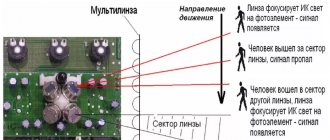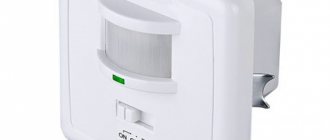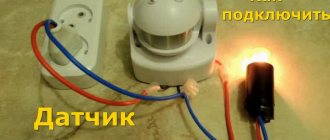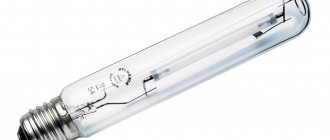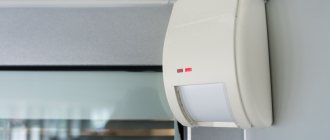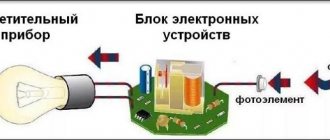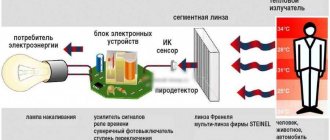06/24/201606/26/2016 master
Today, thanks to technological developments, it has become possible to automate some household processes and make them more rational and economical. Such technologies are especially in demand in public utilities. One of these innovative solutions of our time are lamps that capture motion.
With their help, you can effectively illuminate not only the interior of a private home, but also public places. Today, such devices are actively installed in the entrances of apartment buildings.
Automation of housing and communal services lighting with sensors for our comfort
Energy is the basis of an effective economy. Issues of energy saving, economical and rational use of energy resources are dealt with at all levels of the system. An installed entrance light with a motion sensor is, of course, a small contribution to the state energy saving program. But all residents of an apartment building have reason to think about caring for the resources that ensure their comfort. And a good habit!
What are the types?
Types of lamps can be divided into several categories.
Depending on the type of installation, lamps can be of the following types:
In terms of power, devices based on ultra-bright diodes with a motion sensor are not inferior to lamps for suspended ceilings, as well as overhead LED lamps.
According to the design of the light source there are:
- Infrared. The most popular models. The operating principle is based on detecting changes in ambient temperature. Only under this condition can the device turn on. Considering that it is human nature to emit infrared light, there is no possibility of false alarms.
- Microwave. The method of operation is in many ways similar to the ultrasonic type. Only in this variety the sensor recognizes the vibration of radio waves. When the wave is interrupted, the contact closes, thereby turning on the light. Works well both outside and in entrances.
- Ultrasonic. They are most often used to create light outside. The device turns on due to the detection of a sound sensor. Also well suited for entrances and front doors.
- Combined. This type of lamp has several sensors simultaneously. This, accordingly, improves the characteristics of the device, which increases its level of efficiency in use. Now it is actively gaining popularity and is gradually replacing infrared models.
Requirements for lighting in the entrance: advantages and features
To paraphrase the well-known statement that the theater begins with the coat rack, we can say that we get the first impression of the house and its residents already at the entrance. It plays the role of a common hallway. Lamps perform several functions:
- decorate the interior and create a special microclimate;
- facilitate the orientation of the residents themselves and workers of various services (housing and communal services, firefighters, postmen);
- provide conditions for repairmen to work in case of emergency situations;
- ensure safety during movement by illuminating steps, barriers, and elevator halls (lighting standards for common areas and entrances are 5-10 lux, for the area around the elevator - 20 lux).
Technical documentation is regularly updated, which sets out the standards and requirements for entrance lighting.
Requirements for the level and method of controlling illumination of entrances
Lighting standards for various parts of the entrance and utility rooms
Before moving on to questions about the possibility of automating lighting control systems, you should understand the standards required by various regulations for this parameter. After all, this will allow us not only to arrange our lamps as efficiently as possible, but will also give us the opportunity to use the optimal automation system in our case.
- As you already understand, GOST entrance lighting has a different standard for different rooms. It is standardized in Table 1 VSN 59 - 88. According to this standard, two types of illumination are distinguished - illumination from fluorescent lamps and incandescent lamps. By the way, the so-called energy-efficient lamps are fluorescent.
- First of all, let's look at staircases and floor corridors. The illumination of these areas when using fluorescent lamps should be 10 lux, but if incandescent lamps are used, then the norm is 5 lux. In this case, the standardization plane is the steps and the floor of the corridor.
Requirements for entrance lighting
- GOST for lighting of entrances with elevators is somewhat different. Thus, elevator halls should have an illumination of 20 lux when using fluorescent lamps and 7 lux for incandescent lamps. At the same time, according to clause 2.27 of VSN 59 - 88, the lamp must be installed in such a way that part of the luminous flux is directed towards the elevator doors. The lighting of entrance halls must meet similar requirements.
- If there are wheelchair spaces at the entrance, they should be illuminated using incandescent lamps. In this case, the standard illumination for them is 20 lux, and the normalized surface is the floor.
- Elevator shafts, if they are not made with mesh fencing, must also have lighting. For them, the norm is 5 lux and is given only for incandescent lamps. In this case, a conventional surface three meters from the lamp is taken as the standardized surface.
- GOST lighting for entrances must also correspond to rooms such as a basement or attic. It is recommended to use only incandescent lamps for them. The lighting standard is 10 lux. In this case, not the entire room should be illuminated, but only the main passages. The same standards apply to garbage collection chambers, electrical switchboards and other similar premises.
Standards for controlling entrance lighting
Automatic lighting in entrances is constantly being modernized. More and more complex and energy-efficient schemes are emerging, and regulations do not always keep up with these changes.
Therefore, for the most part, they are advisory in nature and place all responsibility on the house design. At the same time, there are certain points that must be taken into account when designing.
Entrance lighting standards
So:
- First of all, it should be remembered that, according to clause 8.1 of VSN 59 - 88, with any method of lighting automation it must be possible to turn it on manually at any time of the day. This is necessary both for repair work and for various unforeseen situations.
- When installing automation systems that respond to room illumination, timely switching on of lighting for rooms with different natural light levels must be provided. This can be achieved by turning on all the lights when the light level is reduced in the darkest place, or by installing additional light sensors.
- When using various sensors, evacuation or emergency lighting must be provided, which is turned on by a regular switch in addition to the automation. With the onset of darkness, it should be constantly on.
- According to clause 8.15 of VSN 59 - 88, switching devices for turning on the attic lighting must be located outside this room. They are usually located at the entrance. If there are several such inputs, then a switching device must be installed on each one.
- All lighting switching devices must ensure that the phase wire is broken. In this case, the presence of phase must be ensured on the secondary circuits of the lighting control system.
Automation of lighting in the entrance: what to pay attention to
Currently, several types of lighting for entrances to multi-storey buildings have been developed for housing and communal services. The choice and implementation of a particular option depends on several factors:
- geographical orientation;
- climatic conditions of the region;
- number of floors of the house;
- availability of services or utility rooms;
- design features;
- regular maintenance by an electrician or electrician;
- level of consciousness of residents, careful attitude towards installed equipment.
Changes may be made to the requirements and standards for the installation of automated entrance lighting systems at the regional level. However, there are mandatory conditions:
- all automated systems must have a manual control mechanism;
- transfer to manual control can be carried out at any time of the day, in the event of an emergency;
- in parallel with the automated one, there is an emergency lighting system; it does not depend on the first one and has a separate power source;
- switches are installed for phase interruption.
How does a motion sensor work to turn on a light?
The principle of operation of the device is quite simple. When motion is detected, a relay is activated, which closes the circuit and electricity is supplied to the bulbs. As a result, the light turns on. The duration of operation of the device is set in the settings. The light can stay on from a few seconds to 10 minutes. This means that if there is no movement, the circuit breaks and the supply of electricity to the light bulbs stops. Eventually the light turns off.
You might be interested in Electric meter Co 505
To ensure normal operation of the system, it is important to connect all elements correctly
Note! To ensure normal operation of the device, many factors must be taken into account. Range, sensitivity and type of sensor matter. It is important to decide on the choice of installation location.
Advantages of sensors in the entrances of residential buildings
The sensors include sensory light-sensitive elements. They respond to changes in light intensity, lack of light or other external factors. The following sensor can be installed in entrance lighting devices:
- passive operation - infrared; it reacts to the appearance of sound or thermal radiation in the work area;
- active action - ultrasonic, microwave, combined; they produce waves of a certain frequency that are capable of detecting and identifying an object or obstacle.
- The preferred mode of operation of the lighting device and its operating conditions will determine the type of sensor with which it is equipped.
What types of motion sensors are there for entrances?
Motion sensors monitor movements and active movements within their coverage area (usually up to 15 meters). They process the information they receive and send signals to turn off or turn on lighting fixtures.
Depending on the configuration and features of the work, there are:
- motion sensor in the entrance;
- installed in lighting fixtures illuminating the local area;
- sensors as part of security systems.
Operating principle of light sensors
Light sensors (photo relays, photo sensors) are also called twilight sensors. They respond to changes in the brightness of natural light flux. Sensors of this type are in great demand in the autumn-winter period, in the off-season.
Combined
This type of sensor combines several tracking technologies, such as microwave and IR. Their parallel operation makes it possible to detect and recognize movement in the work area with great accuracy. Unlike light sensors, they monitor movements around the clock. In addition, combined sensors are capable of monitoring electrical equipment located in the entrance.
Advantages and disadvantages of lamps with a motion sensor
- Economical. Modern lighting devices consume much less electricity than standard incandescent lamps. If such products are installed by utility companies, there is a possibility of lower prices for light.
- Easy to operate and maintain. The device requires periodic cleaning from dust. If necessary, the components of the devices are changed. From time to time you need to inspect the lamp for mechanical damage, serviceability of the motion sensor, and integrity of the lampshade.
- Easy to set up. If you follow the instructions, you can set the desired operating mode of the device. For example, you can turn it off during the day and set it to work only at night. The lamp duration can also be adjusted.
- Easy to install.
- Autonomy. There are options that run on batteries or rechargeable batteries. They do not need to be connected to a centralized power grid. Products require periodic replacement of power elements.
- High brightness of the lamp.
- They're not cheap.
- If the device is exposed to moisture, it will quickly fail, so you should not install it outdoors.
- Depressurization of the lampshade negatively affects the operation of the device.
Incandescent lamps are becoming a thing of the past. They can be replaced by modern, economical lamps that last at least 5 years. Devices supplemented with motion sensors only work when necessary.
Useful tips Connection diagrams Principles of operation of devices Main concepts Meters from Energomer Precautions Incandescent lamps Video instructions for the master Testing with a multimeter
Necessity and problems to be solved
Passage corridors, staircases and vestibules are classified as premises where people's stay is temporary. Constant intense lighting is not needed here. In such rooms, lighting systems and lamps with a motion sensor are installed. Using sensor elements, they regulate the brightness of the light flux, allowing you to save and use energy economically.
- Protection from injuries - you can see where to go and what to step on.
- Saves energy - operates only when needed.
- Free time - no need to turn it on and off often.
- Video surveillance is part of security systems.
What types of lamps are there?
Now you can find the following types of lamps:
- Infrared.
- Ultrasonic.
- Microwave.
- Combined.
Related article: Plastic kitchen apron: photo of Leroy, with photo printing, reviews, how to attach and glue it yourself, video instructions
Let's talk about each of them in more detail.
Infrared are considered the most popular, as they have a fairly low cost and are considered practical. Such lamps can work best in any room. They are triggered by temperature fluctuations, that is, only by humans or animals. We recommend installing these types of lamps because of their practicality and versatility. You can discover the principle of IR lamps by simply watching the following video. The principle of ultrasonic is based on the fact that they constantly emit ultrasonic vibrations. As soon as someone appears, the signal is interrupted and they light up. You can find several dozen excellent models on the market.
If we talk about microwave lamps, they are similar to ultrasonic ones. The only difference is that the radio wave spectrum is used instead of sound. Noting the combined ones, they can be called more reliable and advanced. Only here you must clearly understand that their cost is quite high.
What type of sensors are best suited for entrances?
The entrances of residential buildings are equipped with lighting devices and systems with active motion sensors (microwave, combined, ultrasonic). They recognize and react with sufficient accuracy to the appearance of people in the corridor or on the site. An infrared motion sensor is not installed in the entrance. It is often triggered by the appearance of animals (weighing up to 25 kg) or simply random objects that enter the entrance from the street.
Anti-vandal lamps for housing and communal services
Low awareness of residents or an unhealthy situation in the area lead to the installation of an anti-vandal lamp to illuminate the entrance. Its body is made of particularly durable materials (plastic, polycarbonate). This makes it difficult for the lighting device to be destroyed by impacts or pressure. Tightly screwed screws and fasteners hidden in the wall prevent the lamp from being stolen.
Fluorescent lamps
For a long time, this type of lamp occupied a leading position among lighting elements. And deservedly so. Fluorescent lamps created a uniform and stable light output, while consuming much less energy. Their soft light did not tire the eyes. And the service life - about 20,000 hours - far exceeded the resource of an ordinary light bulb, designed for 1000 hours of burning.
The content of mercury vapor made them non-ecological. And the high probability of destruction of the fragile flask and contamination of the air in the room with these vapors is simply dangerous.
The rapid filling of the lighting products market with LED designs has replaced fluorescent lamps.
LED designs as the best solution for today
Recently, LED lamps have been mainly used to illuminate entrances. They are environmentally friendly and do not emit harmful substances during combustion. This type of lamp is resistant to continuous on-off operation. This property allows you to create systems from them and operate them automatically.
In order to save money, lamps in entrances, technical and other common areas are constantly burning at 15-20% of their power. And when motion (noise, heat) is detected, the LED lamps for housing and communal services with a sensor light up brighter. In passage corridors and places where people temporarily stay, this lighting mode is justified. And LED light sources do not deteriorate and their service life is not reduced.
The service life of LED dumps guaranteed by the manufacturers is 30-50,000 hours of intensive use. This is several times higher than the resources of other types of lamps. For example, lamps with general incandescent bulbs are designed for only 1,000 hours of operation. And energy-saving lamps will burn for 5-15,000 hours.
Disposal of LED lamps does not require special conditions. If a lamp with such a lamp is destroyed as a result of mechanical impact, then sharp fragments and hazardous substances will not appear. The use of a board with electrical circuits in such lamps makes theft difficult and makes the theft of individual elements impractical.
Self-installation
Installing a lamp with a sensor is a fairly simple operation that does not require special skills. Not only an experienced electrician, but also a beginner can easily handle the installation.
Selection rules
Before you start installing a light bulb with a motion sensor, you need to choose and buy it correctly
To do this, you need to take into account the main characteristics of the light source and use the option that will meet all the requirements. When choosing a lamp, consider the following parameters:
- Device power. This indicator may vary in different devices. It allows you to determine the degree of brightness and intensity of radiation.
- The power of light. For each specific case, you should choose one or another option. The higher the value of this parameter, the brighter the light produced will be.
- Color temperature. This indicator allows you to select the optimal color rendering option that meets the requirements of the owner of the room. A small value will correspond to warmer shades, and a large value will correspond to cooler shades.
- Scattering angle. This characteristic must fully comply with the design of the lighting fixture.
- Base type. There is no point in experimenting here. It is recommended to choose standard options with holder E27 and G13. Thanks to this, the llama will fit almost all lamps.
- Required power source. The indicator must correspond to 220 V.
- Device dimensions. This parameter is important when installing in a lamp.
Sensor parameters:
- Detection range of a moving object.
- The duration of exposure until the lighting is turned off.
- Radius of the device.
Installation of a lamp with a built-in sensor
Most often, a light bulb with a built-in motion-activated sensor is installed in a lamp or any other similar device. It can be mounted indoors (on the wall, ceiling) or outdoors. The installation process is simple and consists of the following steps:
- Light bulbs and lighting fixtures must be prepared for installation.
- The installation site is disconnected from electricity. This can be done by pressing the switch located on the panel.
- Wiring is connected to the device.
- The device is securely attached to the selected surface.
- A light bulb with a sensor that reacts to movement is carefully screwed into it.
- The lamp is connected to the power source and tested.
Connecting the device to an external device
If the purchased light bulb is equipped with a remote sensor, then its installation in the lighting device is carried out using a different technology. It has its own features that allow you to get the desired result. Installation steps:
- A location with the maximum possible viewing angle is selected.
- A lighting fixture is attached to the wall or ceiling.
- The edges of the wire are carefully cleaned.
- The terminal box cover is opened and all necessary wiring is connected.
- The connection points are additionally insulated.
- At the next stage of work, the purchased lamp is attached. To do this, one end of it is attached to the neutral cable, and the other to the phase.
- The contacts are wrapped with insulation and compressed tightly.
Popular LED lamp models
The variety of shapes and colors used in LED lamps allowed them to become not only lighting devices, but also decorative elements when decorating entrances. Popular models include:
- Lamps with a sound sensor (SA-7006D, SA-7006, SA-7008U): they have a vandal-proof design; the housing, made of impact-resistant polycarbonate, makes it difficult for the device to be damaged by impact or other mechanical impact; the structure is attached to the wall using hidden screws, which makes it almost impossible to steal;
- ERA LED T8: budget version of the luminaire with LED lamps; has a completely impenetrable waterproof body, which makes it possible to place it in rooms with high humidity and constant temperature fluctuations; works with changes in network voltage in the range of 190-250 V; weight 167 g; service life – 2-3 years;
- GLOBAL GBH LED luminaire: an inexpensive option with a sealed housing that provides complete protection from dust and moisture; equipped with a driver that stabilizes voltage within 165-265 V, and a light diffuser with an angle of 120°; The body of the model is resistant to deformation and discoloration due to sunlight;
LED
The advantages of using diodes in lighting are enormous: compared to incandescent or fluorescent lamps, these light sources consume the least amount of electricity, they are compact and have become very affordable. Even budget housing and communal services lamps have the longest service life from 30,000 to 50,000 hours. Luminous flux decreases by only 10-15% over three years.
In the housing and communal services sector, LED lamps are especially relevant due to the constant increase in tariffs for electricity consumption.
LEDs take up little space and do not require a significant heat dissipation system. This allows you to place bright light sources of various powers in a compact housing.
12W
The most popular power of a housing and communal services lamp is 12W, comparable in brightness to an incandescent lamp of 100W or higher. Models with a power of 8W and 18W are also in demand - they shine at 70W and 150W, respectively. LEDs, unlike the same incandescent lamps, can differ significantly from each other in terms of light output. Two LED housing and communal services lamps of the same power from different manufacturers have different brightness
When purchasing lighting sources, pay attention to luminous flux and light output indicators. If the light output is not lower than 80 Lm/W, then you have a product of acceptable quality that will really reduce energy costs
Since LEDs do not require replacement or periodic maintenance, the body of such an entrance lamp is made from a small number of parts with a simplified disassembly system. In turn, this makes it possible to produce inexpensive lighting devices that are protected from dust and moisture.
Waterproof IP65 and IP54
In entrances, basements and other rooms in which housing and communal services lamps are used, as a rule, the content of dust and moisture is increased. Therefore, these lighting devices are made of durable materials, the junction of the housing and the diffuser is equipped with a silicone seal, and the wire entry point is equipped with a sealed coupling.
The degree of dust and moisture protection is indicated by the IP indicator in accordance with the international standard IEC 60529 (duplicated in GOST 14254).
Consists of two digits. The first digit can have values from 0 to 6 and indicates the degree of protection against the ingress of solid objects, including dust. The second number indicates the device’s resistance to water penetration on a scale from 0 to 9.
IP65 and IP54 are deciphered as follows:
| Solid object protection "6" - dustproof |
| Moisture protection “5” – protection against water jets from all directions |
The degree of moisture protection of the housing and communal services lamp IP65 means that it is completely protected from dust, as well as from jets of water from all directions. Such devices can also be installed outdoors, especially if the wire enters the housing through a special tight connector. If the assembly is in doubt, it is recommended to mount the lamp under a canopy or canopy
Also, if the wire is removed, when connecting, you need to pay special attention to insulating the junction with the power supply cable
The IP54 marking corresponds to the protection of the product from the penetration of dust in quantities that do not affect its performance, and from splashing water from all directions. This type of protection for the entryway lamp is sufficient for most rooms, except shower rooms.
Do-it-yourself installation recommendations
Only a person with special knowledge, an electrician or electrician, can correctly install and configure an LED lamp. Algorithm for installing an LED lamp:
- select the installation location (wall, ceiling, corner) in accordance with the design of the lamp and the type of built-in sensor;
- turn off the power supply;
- connect the device to the electrical network; To do this, it is not necessary to create a new one; an energy-saving LED light bulb will work perfectly in an existing one;
- configure the sensor or set a timer for a certain period of time.
Motion sensor system
A lighting system with a motion sensor installed in the entrance is capable of detecting movement at a distance of 15 meters.
Light sensor system
It is advisable to install systems with sensors of this type in well-lit entrances. Typically, the entrance doors open to the east, and the sun illuminates the entrance throughout the day. The lighting fixture with the sensor is installed in the darkest corner. And it works after dusk.
Lighting control system using push-button stations
In small-family and low-rise buildings, a remote control with push-button control of lighting in the entrance can be installed. There are two options for equipping push-button posts:
one of the posts is installed at the entrance to the entrance, it is used by incoming residents; by pressing a button they turn on the lights; a second post with a light switch button is equipped on each staircase; residents use it when they find themselves at the door of their apartment;
at the first post, equipped at the entrance, only the lighting on the staircases is turned on; There are separate buttons at each site to turn on the lighting fixtures in the corridors.
Sometimes, instead of push-button posts, several switches are installed in the direction of people’s movement. This complicates the electrical circuit a little. Often a timer is built into the system. After a certain time (up to 30 seconds) it is triggered and gives a signal to break the circuit. Equipping push-button stations for lighting control is considered the most cost-effective option.
Obviously, it is advisable to install such control systems in entrances with a large number of young and responsible residents. Forgetfulness and limited mobility are characteristic of older people; they will negate the possible economic effect of the system.
Combined lighting systems
At the same time, general lighting of the entrance and point sources of artificial light are used in work areas, for example, at the security post, at the concierge, in technical rooms. Lighting devices in work areas are turned on as needed, after the arrival of service personnel.
Source
Automation of staircase lighting
One of the most important factors in the comfort of residents of apartment buildings is high-quality lighting in the entrance. At the same time, the cost of lighting entrances constitutes a significant share of general house costs. Often, landings are illuminated with ordinary incandescent lamps, which work even during daylight hours, and the problem of excessive energy consumption is solved by simply unscrewing some of them. This raises the question of the possibility of organizing lighting for staircase landings in another, more economical and technologically advanced way. This problem interested me because I encounter it every day and would like to find a way to solve it using the example of my entrance. Goal: to create a device for automating the lighting of staircase landings of apartment buildings.
Tasks:
- Familiarize yourself with the main problems of organizing lighting for the entrances of residential buildings.
- To get acquainted with existing technologies for lighting the entrances of residential buildings, and choose the most economically advantageous device concept that meets the requirements of manufacturability.
- Design and manufacture a device for automating the lighting of staircase landings that achieves energy saving goals.
Object of study: Lighting of staircase landings of apartment buildings.
Subject of research: Reasons for the irrational use of electrical energy for lighting the entrances of apartment buildings.
Problems of organizing lighting for residential building entrances
Any entrance to a residential building must be equipped with artificial lighting in accordance with the requirements of sanitary standards. (clause 3.2.2 SanPin 2.1.1/2.1.1.1278-03). As a rule, such lighting is organized using incandescent lamps controlled by a standard switch located on the wall. Incandescent lamps are a futile and uneconomical source of artificial lighting compared to modern fluorescent and LED lamps. The situation is aggravated by ineffective lighting control, which is usually carried out by residents independently. The lighting turns on on the landing with the onset of darkness and turns off (unfortunately, not always) with the onset of daylight. As a result, unnecessary energy consumption occurs. The problem can be solved by using modern, economical light sources, as well as using automation tools for controlling the lighting of staircase landings.
Search for the concept of a future device
A device for automating staircase lighting can be manufactured in different ways, both from the point of view of circuit design and from the point of view of the physical embodiment of the final product.
Schematically, the device can be implemented both on discrete components and using digital integrated circuits, including microcontrollers, as well as ready-made modules. The appearance of the finished device can be made in the form of a finished device that includes not only the automation device itself, but also a lighting device, being integrated with it. Another design option looks like a device mounted instead of a standard switch, or a device mounted in close proximity to the lighting fixture, on the ceiling.
The market mainly contains models made in the form of a complete lamp that replaces a standard lighting fixture. Which requires dismantling the last one and, accordingly, installing a new one. The samples presented on the market are equipped with a motion (presence) sensor to turn on the lighting only when a person is present on the landing, as well as a photosensor to ensure that the lighting is turned on only in low light conditions, which ensures energy savings when using such automation equipment.
In this case, the motion (presence) sensor can be made using three main technologies:
- Infrared sensor with Fresnel lens.
- Acoustic sensor.
- Microwave sensor based on the Doppler effect.
From a technological point of view, I see the most promising idea: choose the appearance of the device in the form of a complete lamp, which includes an automation device and a lighting device.
This choice was dictated by the fact that: the version of the device made in the form of a block mounted instead of a standard switch seems to me difficult to implement due to problems associated with the power supply of the device. The fact is that, since the switch is installed in the open circuit of the lighting device’s power supply, only one pole of the supply network is suitable for it, which is not enough to power the device, and laying the second pole of the supply network to the switch is not always possible, and is not technologically advanced . The option of a finished device in the form of a block mounted next to a standard lighting fixture, despite its lower cost, does not seem rational to me due to the complexity of its installation in the presence of hidden wiring. I see the most rational technology for detecting the presence of a person - a microwave sensor based on the Doppler effect. For a number of reasons: a microwave sensor, unlike an infrared sensor, does not impose requirements on the installation location and is capable of detecting movement through obstacles covering it. Also, a microwave sensor does not require any additional manipulation from a person (clap your hands) in contrast to an acoustic sensor. In addition, the electronic components market offers ready-made modules of microwave motion sensors combined with a light sensor, the cost of which, due to mass production in China, is low.
From the above, it follows that from a circuit design point of view, it is most rational to implement the device using a ready-made microwave motion sensor module combined with a light sensor.
Final idea
The final idea is to use an off-the-shelf Doppler microwave motion sensor module RCWL-0516:
The operation of the sensor is based on the Doppler effect - a change in the frequency of the reflected wave due to the movement of the reflecting surface. The module has a standard ability to connect a photoresistor to control the operation of the module depending on the illumination. The response threshold of the light sensor is set by selecting a resistor, the mounting location provided on the module board. Also on the module board there is a place for installing a capacitor responsible for determining the time period during which the lamp will be turned on after the motion sensor is triggered. Thus, the principle of operation of the finished device will be as follows: when motion is detected in the sensor’s coverage area, and under conditions of insufficient illumination, the lighting will be turned on for a certain period of time sufficient to overcome a flight of stairs.
Module specifications:
- Supply voltage 4-28 V DC
- Current consumption: up to 3 mA
- Detection range: up to 9 m
- Transmitter power: up to 30 mW
- Operating temperature range: -40-+100 C
- Dimensions: 17.3×35.9 mm
- Weight: 4 gr.
The sensor has 5 pins:
- OUT sensor output (set to logic 1 when there is movement) maximum load 100 mA
- VIN supply voltage input +4-28v
- GND power input (-)
- 3V3 stabilizer output 3.3v
- CDS operation permission input
- CDS pins on the opposite side of the module for connecting a photoresistor.
Since the module is powered by low DC voltage, it will need a power supply.
The simplest option for implementing a power supply, given that the module consumes little current, in this case would be to use a transformerless power supply, as it is the simplest and has small dimensions and cost. Also, due to the fact that the device will control a high-voltage load, an appropriate circuit actuator will be needed. The quality of the chosen high-power field-effect transistor from the IRF740 company was dictated by the compliance of its electrical parameters with the required ones, as well as the low resistance of the open channel of the transistor, which will ensure low power dissipation on the transistor and, accordingly, no need to use a radiator, which will have a positive effect on the cost and weight and size indicators devices. In total, the approximate diagram of the device looks like this: Fig. 1
Diodes D1-D4 form a rectifier bridge, the pulsating voltage from which is supplied to a parametric stabilizer formed by elements R1, D5, C1. A voltage of 12 volts filtered by capacitor C1 (this is the voltage the zener diode D5 is designed for) from the output of the stabilizer is supplied to the power inputs of the module. Since the current consumption of the module is not large, little power is released on resistor R5. At the moment the sensor is triggered, a logical one voltage appears at the output of the module, which is applied to the gate of transistor Q1, which leads to its opening and switching of the load.
The load of the device is an LED lamp with a power of up to 10 W.
In this circuit, it is powered by a pulsating current that is constant in direction, which, however, does not in any way affect its performance.
As the body of the finished device, a ready-made plastic lamp will be used, designed for the use of modern LED lamps; the polymer material of the lamp body will ensure the safety of the device, due to the use of a transformerless power supply in it.
The cost of the product does not exceed the cost of industrial products, but at the same time it surpasses it in technical characteristics, which proves the feasibility of making this device with your own hands.
Self-analysis of the work done
While working on the project, I solved all the tasks I had set myself to solve the problem of lighting the entrances of apartment buildings. I also had the opportunity to learn about existing motion detection technologies, their differences, advantages and disadvantages. Learned how to calculate a parametric stabilizer. I got acquainted with the operating principle and distinctive features of field-effect transistors with an induced channel.
Why install light sensors and motion sensors
After the approval on September 1, 2016 by the government of the Russian Federation of a road map for increasing the energy efficiency of buildings and structures and after the adoption of a number of regulatory legal acts, the topic of using all possible ways to save energy resources became relevant again.
Installing light sensors and motion sensors in the house, in addition to the listed advantages, will relieve the workload of full-time employees of the management organization, housing cooperatives and homeowners associations. They will not need to change burnt-out “Ilyich lamps” every other day and respond to calls from residents.
The person responsible for the maintenance of the apartment building, at least once a year, is obliged to develop and bring to the attention of the owners of premises in the apartment building proposals on measures to save energy and increase energy efficiency in the apartment building.
Motion sensor connection diagrams
Now let's talk directly about connecting motion sensors to the lighting network. There are two options here - direct connection and connection through an additional switching device. Usually a starter is used as such.
Direct connection of motion sensors
Direct connection of motion sensors can be used in cases where the total load of the lighting network switched by the sensor does not exceed its nominal parameters.
Connecting a motion sensor
So:
- As an example, let's take the lighting in the entrance with a motion sensor. For this connection we need three wires.
- From the distribution box, we first connect the sensor itself. To do this, we first connect the neutral wire from the group wire to the sensor, and then the phase wire.
Wire color code
- Now we connect a lamp or group of lamps. We take the neutral wire from the group wire in the distribution box. And the phase wire is from the third terminal on the motion sensor.
- When the sensor is triggered, the relay is triggered and its power contacts close, resulting in voltage appearing at the third terminal of the motion sensor. It will remain in the activated state until the timer built into the sensor runs out.
- After this, the coil inside the sensor will fall away and open the circuit. As a result, the voltage at the third pin will disappear and the lighting will go out.
Diagram of direct connection from several sensors
But there is one more nuance here. According to clause 6.5.7 of the PUE, if a motion sensor is used for lighting, then the possibility of manual activation must be provided. This is achieved by installing a conventional switch.
Connecting the sensor in parallel with the switch
In this case, a switch is installed in our circuit parallel to the motion sensor. It is connected from the phase wire in the distribution box and the second contact is connected to the phase wire that powers the lamps. Thus, it bypasses the motion sensor and ensures that the light turns on, even if it breaks down.
Connecting a motion sensor via a starter
But in some cases, lighting with a motion sensor can only be turned on through a starter or other switching device. This is necessary if the total load of the lighting network exceeds the rated current of the sensor, as well as for some lighting control circuits.
| For this circuit, the lighting machine with a motion sensor is powered in series. That is, directly from the machine that powers the group, we power the starter and the motion sensor, sometimes several sensors at once. | Connecting a motion sensor via a starter |
| To do this, we directly take the phase from the group circuit breaker, and take zero from the zero bus of the lighting board to power the sensor. The output from the motion sensor is connected to the starter coil, and on the other side the coil is connected to the zero of the lighting panel. | Starter coil connection |
| If you plan to have autonomous lighting with motion sensors, then you will need to connect several of these devices. In this case, the connection is made by analogy with the above option. | Connecting motion sensors using “or” logic |
| If your circuit provides for the lighting to be turned on only when several motion sensors are triggered at once, then in this case the phase output of one sensor is connected to the input of the second. And from its output, power is supplied to the starter coil. | Connecting motion sensors using “and” logic |
This type of connection is subject to the requirement of clause 6.5.7 of the PUE. To do this, a push-button station is usually installed parallel to the motion sensors. This allows you to turn on the lighting in both automatic and manual mode.
How to install light sensors in MKD
Management organizations, homeowners' associations and housing cooperatives do not have a direct obligation to install light sensors in apartment buildings. Such an obligation is not provided for by the Minimum List of Services and Works approved by Decree of the Government of the Russian Federation dated April 3, 2013 N 290.
At the same time, pp. “g” clause 10 of the Rules for the maintenance of common property in MKD, which was approved by Decree of the Government of the Russian Federation of August 13, 2006 N 491, establishes the obligation to comply with the requirements of the legislation of the Russian Federation on energy saving and on increasing energy efficiency.
If the house is serviced by a management organization, then the installation of light sensors will require an OSS solution, unless, of course, the building authority installs the light sensors at its own expense. In the second case, all you need is a management decision and proper funding. Taking into account the fact that the management organization always has an electrician on staff, it does not seem difficult to install light sensors at least on the first floors.
If the apartment building manages a housing cooperative or a homeowners association, then a prerequisite for financing the installation of light sensors must be the approval of this expense item in the estimate of income and expenses. This estimate is approved:
- at the general meeting of HOA members,
- through targeted financing,
- by including the column “other expenses” in the estimate.
The installation of light sensors can be financed from the capital repair fund if the established contributions for capital repairs exceed the minimum established in the region.
Remember that in this case, you can spend the difference between the regional minimum and the actual fees for major repairs on any type of work only with the consent of the OSS. The decision must be made by ⅔ votes (Part 3 of Article 166 of the RF Housing Code).
How to install a sensor to turn on the lighting
Installation of the device is carried out according to a fairly simple scheme:
- Selecting an installation location.
- Bracket attachment.
- Sensor installation.
- Connection and configuration.
- Checking the work.
Please note! If we are talking about built-in models, then their installation should be provided for at the stage of repair work. This is due to the fact that installation will require the arrangement of a special niche, the dimensions of which must correspond to the dimensions of the device.
What rules must be followed when installing light sensors
The installation of light sensors does not require any special approvals from supervisory authorities, in particular, fire supervision. But there is one mandatory requirement that must be taken into account during installation - the horizontal distance from fire alarm detectors to electric lights must be at least 0.5 meters. This requirement follows from clause 13.3.6 N SP 5.13130.2009.
The utility networks on which light sensors are installed are the common property of the apartment building (Article 36 of the Housing Code of the Russian Federation). Responsibility for the maintenance of common property lies with the management company, HOA or housing cooperative. (part 2.1, 2.2 of article 161 of the Housing Code of the Russian Federation). Therefore, it is impossible to install light sensors without the permission of the management organization.
To work on cable power supply lines, you must have the appropriate permit, and for this you must undergo periodic training at Rostechnadzor. This is required by clause 3.4.59 of the Rules for the Technical Operation of Consumer Electrical Installations, approved by Order of the Ministry of Energy of the Russian Federation dated January 13, 2003 N 6.
Two-wire connection of a motion sensor
First of all, decide what sensor model you have based on the type of connection. They come in two and three wires.
First, let's study the simplest two-wire circuit.
Two-wire motion sensors are most often installed in ordinary socket boxes. The general picture of its connection consists of 4 elements:
automatic switch for 220V power supply
junction box
the sensor itself
lamps
Connecting the device is similar to installing a single-key light switch. That is, you need to bring the power phase to the sensor and pass it through it to the lamp.
In this case, it is better to use the “sensor-lamp” combination on a separate circuit, rather than placing it on general lighting.
Let's look at the installation process from the very beginning. First of all, run the three-core cable VVGng-Ls 3*1.5mm2 from the machine in the panel into the junction box. Designate and mark its conductors: phase, zero, ground.
Next, stretch the two-wire wire to the location where the sensor is installed.
Where is the best place to place it?
The classic option for models installed in a socket box is at a height of 1.2-2.0 m from the floor level.
Do not confuse them with wall-mounted devices placed in walk-through corridors or entrances of high-rise buildings, or at the entrance to a building. These usually go up to the very ceiling, not far from the doors.
Also make sure that no open doors block the sensor's viewing angle
It is also not recommended to place them above a radiator or other heating devices.
Next, we also run the cable going to the lamp into the junction box. Inside it we connect all the wires in the following sequence.
First zeros. From the power cable to the lamp cable.
Next is grounding, if there is one of course.
But we connect the phase from the machine to one of the cores that goes down to the sensor (L). We connect the second core from the sensor cable to the lamp (L sensor).
All that remains is to connect the sensor itself in the socket box. We connect the incoming phase with the symbol L to the corresponding terminal.
We connect the second core to the terminal where the lighting fixture or the “load” sign is drawn, as in the figure below.
All that remains is to hide the entire mechanism in the socket box and install a decorative frame.
Next, we make settings on the front panel. To do this, unscrew all the “flags” in order.
1 - put the device into automatic mode
2-set the sensitivity threshold
So that the sensor does not turn on during the day or at other times of the day that you do not need, depending on the level of illumination and the strength of the luminous flux.
3-set the time after which the lighting will turn off as soon as there is no movement in the device’s coverage area
That's all. Apply voltage and check the operation of the entire circuit.
The advantages of such a two-wire circuit and motion sensor data:
ease of installation and connection
Possibility of forced switching on of lighting without additional light switches
versatility
You can easily replace any single-key switch with a similar device and automate your lighting system, without any capital costs.
However, there are also disadvantages. These devices often do not work well with energy-saving and LED light bulbs.
They begin to flicker, sometimes very strongly.
What happens after installing light sensors
The management organization is not obliged to install light sensors and motion sensors in apartment buildings. But if installed, you will receive the following benefits:
- saving energy resources;
- improving the energy efficiency class of MKD;
- improving attitude towards the management organization, HOA or housing cooperative.
You will feel savings from the use of energy resources within the next month. It will be reflected in receipts in the form of a reduction in the payment for a utility resource for the maintenance of common property.
Author of the article: Pavel Kuznetsov , chairman of the Ladoga HOA, author of the book “HOA. A practical guide to managing an apartment building."
Source
